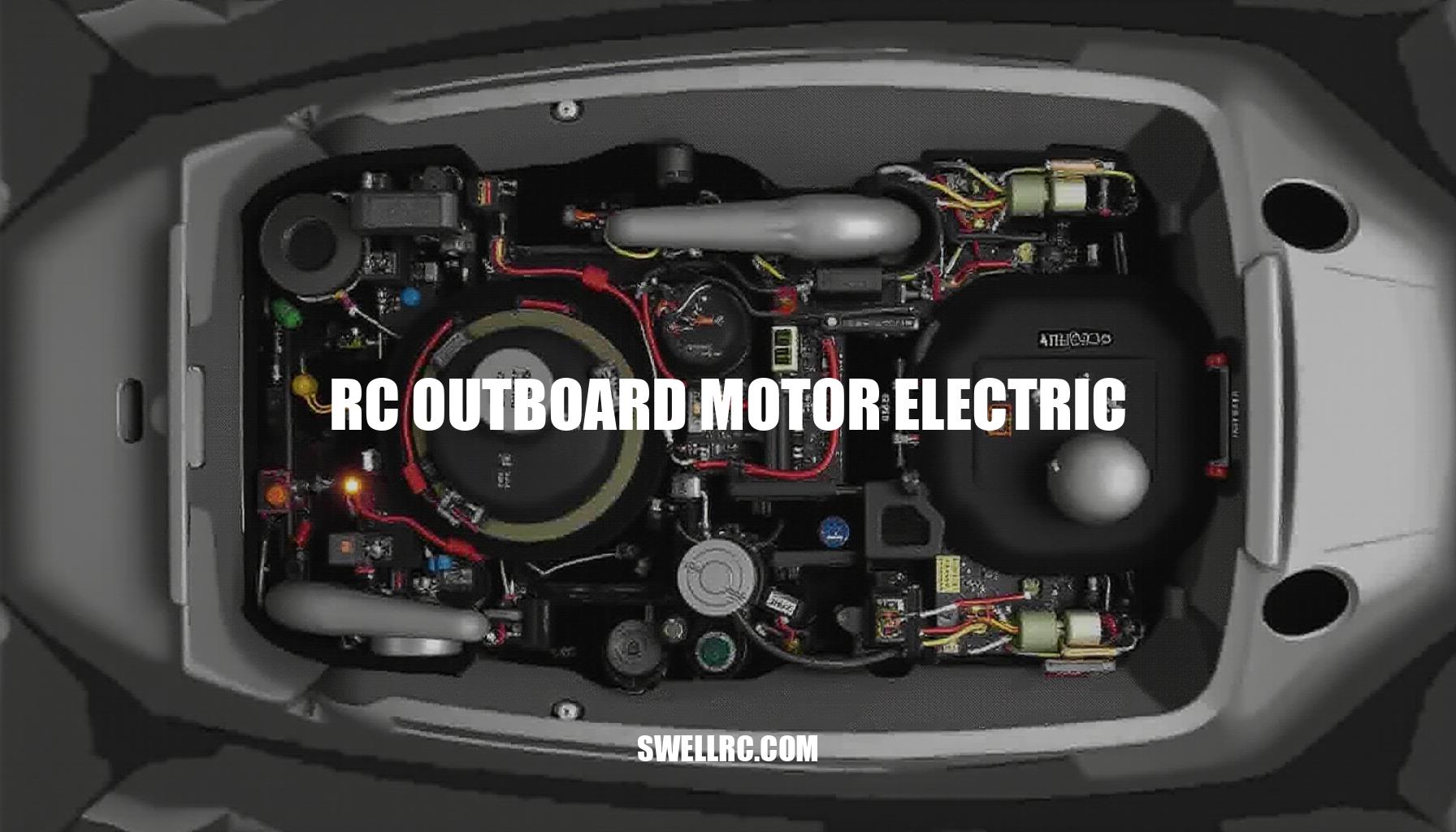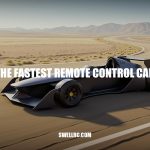Optimizing RC Outboard Motor Electric Performance
I’ll never forget the first time I put a brushless electric outboard on my model boat for a shakedown run. The moment I opened the throttle, the response was instant—smooth and powerful with hardly a whisper in the water behind me. To my surprise, it even beat my trusty nitro-powered racer off the starting line, showcasing the impressive torque and control that electric setups deliver.
This experience perfectly captures why so many hobbyists are making the rapid transition from traditional nitro and gas-powered RC boat motors to electric marine propulsion—driven by unmatched efficiency, precision control, and the near-zero maintenance that electric systems promise.
In this guide, you’ll learn exactly how electric outboard motors work, the critical considerations for selecting parts that harmonize with your hull’s size and style, and the essential wiring and waterproofing techniques that ensure longevity. Plus, we’ll dive into tuning tips to optimize your build for both speed and reliability, whether you’re hobbying for fun or gearing up for competition.
The market today is vibrant, offering everything from beginner-friendly plug-and-play model outboard motors to advanced, pro-level modular systems that give enthusiasts full control over performance customization. For those curious to explore options tailored to different scales and styles, platforms like SwellRC’s model outboard selection provide a fantastic overview.
Whether you’re upgrading your remote control boats or building an RC speedboat engine from scratch, understanding this ecosystem opens up a world of possibilities in electric marine propulsion.
The Core Mechanics of Electric Outboard Power
When diving into motor types for RC boats, it’s essential to grasp the fundamentals. Brushed motors are the simpler, more affordable option but require regular maintenance due to brush wear. On the other hand, brushless motors offer higher efficiency, greater power density, and minimal upkeep, making them the preferred choice for modern brushless RC outboard motors that demand reliability and performance.
Understanding the physics behind motor selection helps optimize your boat’s performance. The KV rating of a motor indicates its RPM (revolutions per minute) per volt. A lower KV means the motor spins slower but delivers more motor torque, perfect for turning larger propellers.
Conversely, a higher KV suits smaller props requiring higher RPM. This relationship allows you to “gear” the system effectively just by selecting the right prop size, as outboard motors rarely use mechanical gearing.
System integration plays a critical role. The Electronic Speed Controller (ESC) handles motor commutation, current limiting, and timing. Choosing a waterproof ESC for boats with water-cooling plates and a stable Battery Eliminator Circuit (BEC) ensures durability and consistent performance in marine environments.
Batteries are equally important—high C-rate lithium polymer batteries provide the aggressive current discharge needed for powerful acceleration. Configuring these batteries in series increases voltage (and thus motor RPM), while parallel setups boost capacity and runtime.
Effective cooling prevents overheating: water pickups channel water through specialized jackets enveloping the motor and ESC. Ensuring proper water flow direction maintains optimal temperatures, extending component lifespan.
Modern RC boat motors are thoughtfully designed to slot neatly into outboard housings, balancing power with compact, marine-grade durability.
| Feature | Electric | Nitro |
|---|---|---|
| Noise | Quiet operation | Significantly noisy |
| Runtime (per pack/tank) | Typically longer, depending on battery size | Shorter, requires frequent refueling |
| Throttle Precision | Highly precise and responsive | Less precise, dependent on carburetor tuning |
| Maintenance | Minimal, especially with brushless motors | High, due to engine tuning and fuel residue |
| Environmental Impact | Clean, no emissions | Produces exhaust and toxic fumes |
Leveraging a robust marine cooling system, selecting the right motor torque and RPM combination, and integrating dependable waterproof ESCs and lithium polymer batteries creates a seamless, high-performance RC boat setup ideal for both casual fun and competitive racing.
Choosing the Right Electric Outboard Setup for Your Hull
When selecting components for RC speedboat engines, it’s crucial to balance several factors to optimize performance. The hull size and weight, including length and displacement, combined with your target speed, primarily determine the power requirements. For instance, a larger hull needs more torque, influencing your choice of motor KV rating.
Lower KV motors suit heavier hulls with larger propellers, while higher KV is ideal for lighter, fast boats.
The battery cell count typically ranges from 2S to 6S. Increasing voltage (more cells) reduces current at the same power but places greater stress on the ESC and motor. Therefore, selecting an ESC with appropriate ESC amp rating is vital, ideally providing 30–50% more capacity than your peak current draw.
Additionally, incorporating efficient water-cooling ensures reliable thermal management during operation.
The propeller pitch and diameter serve as the “final drive” of your setup. It’s best to start conservatively with smaller props and gradually increase pitch or diameter to find the optimal balance between speed and torque. For example, a mid-size offshore deep-V hull often pairs with a moderate KV motor on a 3–4S battery setup, utilizing medium to large props to ensure sufficient torque-to-weight ratio.
In contrast, a small hydro plane favors a high KV motor at 3–4S with smaller, higher-pitch props for rapid acceleration and top-end speed.
Deciding between external outboards versus inboard or jet drives depends on your application. External outboard units are advantageous for RC boats requiring precise trim and steering authority, thanks to their articulated mounting, as detailed on SwellRC’s outboard resource. This design is ideal for scale cruisers and smaller vessels needing agile handling, whereas inboard or jet setups excel in streamlined high-speed applications.
| Boat Type | Typical Motor KV | Battery Cell Count (S) | Prop Range (Diameter x Pitch in inches) | Expected Speed Envelope (mph) |
|---|---|---|---|---|
| Offshore Deep-V | 800–1200 KV | 4S–6S | 1.4″–1.8″ x 1.6″–2.2″ | 40–60 |
| Scale Cruiser | 1100–1500 KV | 3S–4S | 1.2″–1.5″ x 1.2″–1.8″ | 20–35 |
| Hydro/Outrigger | 1500–2200 KV | 3S–4S | 0.9″–1.2″ x 1.0″–1.5″ | 50–80+ |
| Catamaran | 1000–1400 KV | 4S–5S | 1.3″–1.7″ x 1.4″–2.0″ | 45–70 |
Ultimately, optimizing your RC speedboat engines involves carefully balancing motor KV, battery cell count, ESC amp rating, and propeller pitch according to your hull and performance goals. Proper attention to the torque-to-weight ratio and cooling capabilities will ensure consistent, high-performance runs on the water.
Building and Wiring: From Bench to Water
When learning how to install an RC outboard engine, it’s crucial to understand wiring fundamentals and the importance of wiring polarity. First, keep high-current wires short, use quality connectors, and avoid tight bends to ensure reliable power delivery. Maintain polarity discipline by color-coding, labeling, and meter-checking all connections before finalizing.
For effective power distribution, incorporate an anti-spark connector, consider an optional inline fuse, and secure battery trays using hook-and-loop fasteners combined with straps for stability.
Waterproofing and cooling are equally vital for optimal performance. Seal deck seams, servo hatches, and cable exits using marine-grade silicone sealant or foam gaskets to achieve a waterproof ESC setup. Establish a proper marine cooling system by routing water flow from the pickup to the Electronic Speed Controller (ESC), then through the motor jacket, and finally out through the outlet.
Always verify water flow at idle in water conditions to prevent overheating.
Achieving the right CG balance and alignment enhances handling and speed. Place the battery to hit the target center of gravity, ensure outboard vertical alignment, and set a slight positive trim as a baseline for stable operation.
Before hitting the water, follow this pre-launch checklist to guarantee readiness:
- Verify radio failsafe to ensure control signal reliability.
- Throttle calibration for responsive speed control.
- Cooling flow test to confirm proper marine cooling.
- Battery secure and balanced CG for stable and effective power delivery.
- Prop tightness and shaft grease application to avoid mechanical failures.
- ESC waterproofing inspection for protection against water ingress.
- Range check to verify control distance.
- Spare props and tools on hand for troubleshooting on the go.
For visual learners, this wiring how-to guide offers detailed diagrams, connector choices, and tips on clean routing. To spark creativity, explore custom projects like gas conversions that demonstrate mounting and driveline fundamentals, available at this resource. By understanding these core concepts—wiring, waterproofing, marine cooling, and balance—you’ll be well-equipped to build and maintain a reliable RC boat engine system.
Performance Optimization: Testing, Tuning, and Upgrades
If you’re looking to master electric RC boat tuning, a comprehensive approach is essential. Start with ESC programming: set the correct timing for your motor, disable the brake, adjust soft-start settings, and set a current limit to protect your battery packs and motor windings. Next, don’t forget throttle calibration, especially after firmware updates or radio changes, to maintain precise control.
Battery optimization is crucial; choose the appropriate cell count based on your speed goals, ensure the C rating comfortably covers your peak current draw, and carefully monitor internal resistance and pack temperatures to avoid performance drops.
Propeller testing is another key step. Incrementally increase diameter or pitch in small steps while observing temperature rises and current spikes. Avoid cavitation and ventilation — common issues that can seriously impact efficiency — by trimming the outboard angle and prop depth.
Incorporating data logging from a programmable marine ESC will help you analyze current draw and thermal performance, making tuning more precise.
For reference parts and sizing, explore motor options and upgrade paths tailored for electric boats available at SwellRC’s Model Boat Electric Motors. Adapt airplane motor sizing logic by focusing on target watts per pound and prop load, as explained in this guide, to better match the power needs of your boat. Additionally, use performance case studies like Max Power W-0.9 RC Boat to benchmark your goals and understand thermal limits.
Here are the top 5 tuning upgrades to elevate your electric RC boat’s performance:
- Higher quality, balanced metal prop to improve thrust and reduce vibrations
- Programmable marine ESC with data logging for accurate current draw monitoring and performance analysis
- Low-resistance connectors and thicker silicone wire to minimize voltage drops and heat buildup
- Water-jacketed motor and dual-pass cooling to efficiently manage motor temperatures
- Stiffer battery with higher C rating and shorter leads for consistent power delivery and reduced losses
By systematically applying these principles and focusing on the key aspects of ESC programming, throttle calibration, battery optimization, and propeller testing, you’ll optimize your electric RC boat’s speed, reliability, and overall performance while steering clear of issues like cavitation and ventilation.
Best RC Boat Types for Electric Outboard Motors
Matching hull types to their ideal outboard motor setups is crucial for optimizing your boat’s performance. For Offshore deep-V hulls, torque-rich, lower KV motors excel in rough waters, providing planted turns and robust handling. Drawing inspiration from rc offshore powerboat designs can guide these choices.
In contrast, Outrigger/hydroplane hulls shine with higher KV motors paired with small props and precise trim adjustments, maximizing efficiency on smooth water surfaces—explore rc outrigger boat kits for insights on weight distribution.
Scale cruisers prioritize extended runtime, smooth throttle response, and minimal noise, achieved through conservative prop selections. Meanwhile, Catamarans benefit from careful center of gravity (CG) and trim tuning, often favoring mid KV motors paired with moderate pitch props to balance speed and stability.
| Hull Type | Stability | Top Speed Potential | Turning Behavior | Setup Sensitivity | Water Condition Sweet Spot |
|---|---|---|---|---|---|
| Offshore Deep-V | High — excels in rough waters | Moderate — emphasis on torque | Planted, predictable turns | Moderate — motor torque vs prop pitch | Choppy, offshore conditions |
| Outrigger/Hydroplane | Moderate — needs smooth water | High — optimized with high KV | Sharp, responsive | High — precise trim and weight critical | Flat, glassy lakes and ponds |
| Scale Cruisers | High — stable and steady | Low to moderate — focus on runtime | Smooth, gradual turns | Low — forgiving with conservative props | Calm waters with long cruises |
| Catamarans | Very high — twin hull stability | Moderate — balance of speed and control | Dependable with careful trim | Moderate — CG and trim vital | Light chop to calm seas |
One advantage of outboard motors across these hull types is their versatility in lakeside tuning. Unlike fixed inboards, outboards allow quick trim and angle adjustments to adapt to varying water conditions, from chop to glassy surfaces, significantly expanding the handling characteristics and usable performance envelope of your RC boat. This flexibility is especially beneficial when operating diverse hull forms like offshore deep-Vs or outriggers, ensuring you get the most out of your setup in any environment.
Common Mistakes and How to Avoid Them
When working on RC outboards, several key lessons emerge that can save you from costly repairs and performance issues. Here are the Top 5 mistakes to avoid:
- Reversing polarity and frying ESCs: Always meter-check your polarity every time to prevent damaging your ESC. A common wiring mistake that leads to overheating and failure.
- Over-propping a high-KV motor: Instead of focusing solely on speed, size your propeller based on the current draw to keep motor temperatures in check.
- Inadequate cooling: Ensure cooling pickups are unblocked and the water is routed properly for a solid stream, preventing thermal issues.
- Underrated ESC: Select an ESC with 30–50% more amp capacity than your measured peak to maintain safe operation and LiPo battery safety.
- Poor waterproofing: Use dielectric grease and proper sealing techniques to protect receivers and connectors from water damage and corrosion.
Understanding the brushless vs brushed RC outboard debate is also essential.
Brushless motors usually offer better efficiency and longevity, making them a worthwhile investment. Conversely, brushed motors may be suitable for scale or budget builds but they tend to limit available prop options and achievable speeds.
For quick fixes to common problems such as overheating and suboptimal performance, consider detuning your propeller pitch or diameter, increasing voltage while lowering prop load, improving ventilation and trim angle, and reviewing your wiring layout for safety and effectiveness.
Conclusion: The Future of Electric RC Outboard Systems
Reflecting on the journey of electric marine propulsion reveals a transformation in boating characterized by precision control, quiet confidence, and notably fast setup times. These electric outboards offer low maintenance advantages due to having fewer moving parts, making sustainability and innovation tangible benefits for modern boaters.
As the modern standard, electric outboards deliver cleaner and more efficient power with programmable behavior that makes boats easier to dial in for any water condition. This innovation not only enhances sustainability but also elevates the overall boating experience through customizable performance.
We encourage experimentation to achieve optimal results:
- Start with a balanced baseline setup.
- Log critical parameters such as motor temperatures and current draw.
- Iterate props and trim settings to fine-tune performance.
Ultimately, select a hull you love, choose an electric outboard that aligns with your personal goals, and enjoy the rewarding process of tuning it into a personal best performer.
Embracing this technology means stepping into a future where sustainability and innovation blend seamlessly with precision control and low maintenance boating.
Frequently Asked Questions
- How does an electric outboard motor work on an RC boat?
A brushless motor inside the outboard converts battery power into rotation, the ESC commutates the phases to control RPM and torque, and the prop translates that torque into thrust. Water-cooling removes heat from the ESC and motor jacket, while the receiver and radio manage throttle and steering via the outboard’s integrated rudder or trim mechanism. - What’s better for model boats — electric or nitro outboards?
For most hobbyists, electric wins on ease, reliability, noise, and tunability. Nitro offers authentic sound and long pit-stop culture, but needs frequent tuning and maintenance. Electric provides instant torque, simple starting, and consistent performance across conditions. - How do I choose the right ESC for an electric RC outboard motor?
Match the ESC’s continuous current rating with at least 30–50% headroom above your measured peak draw, ensure voltage compatibility with your chosen LiPo cell count, and prefer a waterproof, water-cooled marine ESC with a stable BEC. Programming options like timing, current limit, and data logging are valuable. - What size battery is best for a high-performance RC speedboat?
Pick a LiPo pack that meets your voltage (cell count) and current needs. For high performance, 3S–6S is common; choose a C rating that comfortably exceeds peak draw and sufficient capacity (mAh) for your target runtime while keeping weight balanced at the CG. - Can I upgrade my existing RC boat motor to an electric outboard?
Yes. Verify transom strength and mounting height, select a brushless outboard sized for your hull, pair it with a compatible marine ESC and LiPo, and re-balance the boat. Plan wiring and cooling before drilling, and test on the bench before water trials. - How do you prevent overheating in electric model boat motors?
Use proper water-cooling with clear flow, avoid over-propping, keep timing conservative, ensure adequate ESC headroom, and verify the outboard’s trim so the prop stays hooked up without cavitation. Monitor temps after each run and adjust prop or voltage as needed. - Are brushless motors worth it for RC outboards?
Yes. Brushless motors offer higher efficiency, more power per gram, cooler operation, and virtually no brush wear, making them ideal for performance and longevity compared to brushed options. - What are common setup mistakes when wiring an RC boat motor?
Reversed polarity, loose or low-quality connectors, long high-current wire runs, no anti-spark, poor waterproofing, and inadequate BEC power to the receiver. Double-check polarity with a meter, use quality connectors, shorten runs, add anti-spark, and seal electronics properly.



